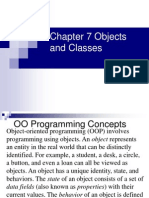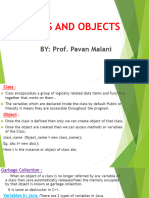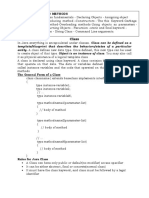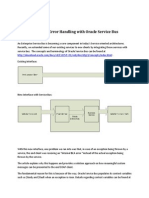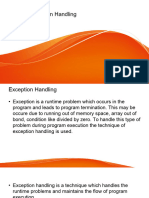Syllabus:: Unit-3: Classes, Inheritance, Exceptions, Packages and Interfaces
Uploaded by
abcSyllabus:: Unit-3: Classes, Inheritance, Exceptions, Packages and Interfaces
Uploaded by
abcObject Oriented Concepts 18CS45
UNIT-3: CLASSES, INHERITANCE, EXCEPTIONS,
PACKAGES AND INTERFACES
Syllabus :
Classes, Inheritance, Exceptions, Packages and Interfaces:
Classes: Classes fundamentals; Declaring objects; Const ructors,
this keyword, garbage collection.
Inheritance: inheritance basics, using super, creating multi level
hierarchy, method overriding.
Exception handling: Exception handling in Java. Packages, Access
Protection, Importing Packages, Interfaces.
.
Beautiful thought: “You have to grow from the inside out. None can teach you, none can
make you spiritual. There is no other teacher but your own soul.” ― Swami Vivekananda
Pradeep B M, Asst.Professor, Dept. of CSE, GMIT. 1
Object Oriented Concepts 18CS45
1. CLASSES:
Definition
A class is a template for an object, and defines the data fields and methods
of the object. The class methods provide access to manipulate the data fields. The
“data fields” of an object are often called “instance variables.”
Example Program:
Program to calculate Area of Rectangle class
Rectangle
{ int length; //Data Member or instance
Variables int width; void getdata(int x, int y)
//Method
{
length=x;
width=y;
} int rectArea()
//Method
{
return(length*width);
}
}
class RectangleArea
{ public static void main(String
args[])
{
Rectangle rect1=new Rectangle(); //object creation
rect1.getdata(10,20); //calling methods using object with dot(.)
int area1=rect1.rectArea();
System.out.println("Area1="+area1);
}
}
Pradeep B M, Asst.Professor, Dept. of CSE, GMIT. 2
Object Oriented Concepts 18CS45
After defining a class, it can be used to create objects by instantiating the
class. Each object occupies some memory to hold its instance variables (i.e. its
state).
After an object is created, it can be used to get the desired functionality
together with its class.
Creating instance of a class/Declaring objects:
Rectangle rect1=new Rectangle()
Rectangle rect2=new Rectangle()
The above two statements declares an object rect1 and rect2 is of type
Rectangle class using new operator , this operator dynamically allocates
memory for an object and returns a refernce to it.in java all class objects
must be dynamically allocated.
We can also declare the object like this:
Rectangle rect1; // declare reference to object. rect1=new
Rectangle() // allocate memory in the Rectangle object.
The Constructors:
A constructor initializes an object when it is created. It has the same
name as its class and is syntactically similar to a method. However,
constructors have no explicit return type.
Typically, you will use a constructor to give initial values to the instance
variables defined by the class, or to perform any other startup
procedures required to create a fully formed object.
All classes have constructors, whether you define one or not, because
Java automatically provides a default constructor that initializes all
member variables to zero. However, once you define your own
constructor, the default constructor is no longer used.
Pradeep B M, Asst.Professor, Dept. of CSE, GMIT. 3
Object Oriented Concepts 18CS45
Example:
Here is a simple example that uses a constructor:
// A simple constructor. class
MyClass
{ int
x;
// Following is the constructor
MyClass()
{
x = 10;
}
}
You would call constructor to initialize objects as follows:
class ConsDemo
{ public static void main(String
args[])
{
MyClass t1 = new MyClass();
MyClass t2 = new MyClass();
System.out.println(t1.x + " " + t2.x);
}
}
Parameterized Constructor:
Most often you will need a constructor that accepts one or more
parameters. Parameters are added to a constructor in the same way
that they are added to a method: just declare them inside the
parentheses after the constructor's name.
Example:
Here is a simple example that uses a constructor:
Pradeep B M, Asst.Professor, Dept. of CSE, GMIT. 4
Object Oriented Concepts 18CS45
// A simple constructor. class
MyClass
{ int
x;
// Following is the Parameterized constructor
MyClass(int i )
{
x = 10;
}
}
You would call constructor to initialize objects as follows:
class ConsDemo
{ public static void main(String
args[])
{
MyClass t1 = new MyClass( 10 );
MyClass t2 = new MyClass( 20 );
System.out.println(t1.x + " " + t2.x);
}
}
This would produce following result:
10 20
static keyword
The static keyword is used in java mainly for memory management. We
may apply static keyword with variables, methods, blocks and nested class. The
static keyword belongs to the class than instance of the class.
The static can be:
1. variable (also known as class variable)
2. method (also known as class method)
3. block
4. nested class static variable
Example Program without static variable
In this example, we have created an instance variable named count which
is incremented in the constructor. Since instance variable gets the memory at
Pradeep B M, Asst.Professor, Dept. of CSE, GMIT. 5
Object Oriented Concepts 18CS45
the time of object creation, each object will have the copy of the instance
variable, if it is incremented, it won't reflect to other objects. So each
objects will have the value 1 in the count variable.
class Counter
{
int count=0;//will get memory when instance is created
Counter()
{
count++;
System.out.println(count);
}
}
Class MyPgm
{
public static void main(String args[])
{
Counter c1=new Counter();
Counter c2=new Counter();
Counter c3=new Counter();
}
}
Output: 1
1
1
Example Program with static variable
As we have mentioned above, static variable will get the memory only
once, if any object changes the value of the static variable, it will retain its
value.
class Counter
{
static int count=0;//will get memory only once and retain its value
Counter()
Pradeep B M, Asst.Professor, Dept. of CSE, GMIT. 6
Object Oriented Concepts 18CS45
{
count++;
System.out.println(count);
}
}
Class MyPgm
{
public static void main(String args[])
{
Output:1
Counter c1=new Counter();
2
Counter c2=new Counter();
3
Counter c3=new Counter();
}
}
Static method
If you apply static keyword with any method, it is known as static method
A static method belongs to the class rather than object of a class.
A static method can be invoked without the need for creating an instance of
a class.
static method can access static data member and can change the value of it.
//Program to get cube of a given number by static method class
Calculate
{
static int cube(int x)
{
return x*x*x;
}
}
Class MyPgm
{
public static void main(String args[])
{
Pradeep B M, Asst.Professor, Dept. of CSE, GMIT. 7
Object Oriented Concepts 18CS45
//calling a method directly with class (without creation of object) int
result=Calculate.cube(5);
System.out.println(result);
}
}
Output:125 this
keyword
this keyword can be used to refer current class instance variable.
If there is ambiguity between the instance variable and parameter, this
keyword resolves the problem of ambiguity.
Understanding the problem without this keyword
Let's understand the problem if we don't use this keyword by the example
given below:
class student
{
int id;
String name; student(int
id, String name)
{
id = id;
name = name;
} void display()
{
System.out.println(id+" "+name);
}
}
class MyPgm
{ public static void main(String
args[])
Pradeep B M, Asst.Professor, Dept. of CSE, GMIT. 8
Object Oriented Concepts 18CS45
{
student s1 = new student(111,"Anoop"); Output: 0 null
student s2 = new student(321,"Arayan"); 0 null
s1.display();
s2.display();
}
}
In the above example, parameter (formal arguments) and instance variables are same
that is why we are using this keyword to distinguish between local variable and
instance variable.
Solution of the above problem by this keyword
//example of this keyword class
Student
{
int id; String name;
student(int id, String name)
{
this.id = id; this.name =
name;
}
void display()
{
System.out.println(id+" "+name);
}
}
class MyPgm
{ public static void main(String args[])
{
Student s1 = new Student(111,"Anoop");
Student s2 = new Student(222,"Aryan"); Output111 Anoop
s1.display(); s2.display(); 222 Aryan
} }
Inner class
It has access to all variables and methods of Outer class and may refer to
them directly. But the reverse is not true, that is, Outer class cannot directly
access members of Inner class.
Pradeep B M, Asst.Professor, Dept. of CSE, GMIT. 9
Object Oriented Concepts 18CS45
One more important thing to notice about an Inner class is that it can be
created only within the scope of Outer class. Java compiler generates an error
if any code outside Outer class attempts to instantiate Inner class.
Example of Inner class class
Outer
{
public void display()
{
Inner in=new Inner();
in.show();
}
class Inner
{
public void show()
{
System.out.println("Inside inner");
}
}
}
class Test
{
public static void main(String[] args)
{
Outer ot=new Outer();
ot.display();
}
}
Output:
Inside inner
Garbage Collection
In Java destruction of object from memory is done automatically by the JVM.
When there is no reference to an object, then that object is assumed to be no longer
Pradeep B M, Asst.Professor, Dept. of CSE, GMIT. 10
Object Oriented Concepts 18CS45
needed and the memories occupied by the object are released. This technique is
called Garbage Collection. This is accomplished by the JVM.
Can the Garbage Collection be forced explicitly?
No, the Garbage Collection cannot be forced explicitly. We may request JVM
for garbage collection by calling System.gc() method. But this does not guarantee
that JVM will perform the garbage collection.
Advantages of Garbage Collection
1. Programmer doesn't need to worry about dereferencing an object.
2. It is done automatically by JVM.
3. Increases memory efficiency and decreases the chances for memory leak.
finalize() method
Sometime an object will need to perform some specific task before it is destroyed
such as closing an open connection or releasing any resources held. To handle such
situation finalize() method is used. finalize() method is called by garbage collection
thread before collecting object. It’s the last chance for any object to perform
cleanup utility.
Signature of finalize() method protected
void finalize()
//finalize-code
}
gc() Method gc() method is used to call garbage collector explicitly. However gc()
method does not guarantee that JVM will perform the garbage collection. It only
requests the JVM for garbage collection. This method is present in System and
Runtime class.
Pradeep B M, Asst.Professor, Dept. of CSE, GMIT. 11
Object Oriented Concepts 18CS45
Example for gc() method public class
Test
{
public static void main(String[] args)
{
Test t = new Test();
t=null;
System.gc();
}
public void finalize()
{
System.out.println("Garbage Collected");
}
}
Output :
Garbage Collected
Inheritance:
As the name suggests, inheritance means to take something that is already
made. It is one of the most important features of Object Oriented
Programming. It is the concept that is used for reusability purpose.
Inheritance is the mechanism through which we can derive classes from other
classes.
The derived class is called as child class or the subclass or we can say the
extended class and the class from which we are deriving the subclass is called
the base class or the parent class.
To derive a class in java the keyword extends is used. The following kinds of
inheritance are there in java.
Types of Inheritance 1. Single level/Simple Inheritance 2. Multilevel
Inheritance 3. Multiple Inheritance (Java doesn’t support Multiple inheritance
but we can achieve this through the concept of Interface.)
Pictorial Representation of Simple and Multilevel Inheritance
Pradeep B M, Asst.Professor, Dept. of CSE, GMIT. 12
Object Oriented Concepts 18CS45
Simple Inheritance Multilevel Inheritance
Single level/Simple Inheritance
When a subclass is derived simply from its parent class then this
mechanism is known as simple inheritance. In case of simple inheritance
there is only a sub class and its parent class. It is also called single
inheritance or one level inheritance.
Example
class A
{ int x; int y;
int get(int p, int q)
{
x=p;
y=q;
return(0);
}
void Show()
{
System.out.println(x);
}
}
class B extends A
{
public static void main(String args[])
{
A a = new A();
a.get(5,6);
a.Show();
}
Pradeep B M, Asst.Professor, Dept. of CSE, GMIT. 13
Object Oriented Concepts 18CS45
void display()
{
System.out.println("y"); //inherited “y” from class A
}
}
The syntax for creating a subclass is simple. At the beginning of your class
declaration, use the extends keyword, followed by the name of the class to
inherit from:
class A
{
} class B extends A //B is a subclass of super
class A.
{
Multilevel Inheritance
When a subclass is derived from a derived class then this mechanism is
known as the multilevel inheritance.
The derived class is called the subclass or child class for it's parent
class and this parent class works as the child class for it's just above (
parent ) class.
Multilevel inheritance can go up to any number of level.
Pradeep B M, Asst.Professor, Dept. of CSE, GMIT. 14
Object Oriented Concepts 18CS45
class A
{
int x;
int y; int get(int
p, int q)
{
x=p;
y=q;
return(0);
}
void Show()
{
System.out.println(x);
}
}
class B extends A
{ void
Showb()
{
System.out.println("B");
}
}
class C extends B
{
void display()
{
System.out.println("C");
} public static void
main(String args[])
{
A a = new A();
a.get(5,6);
a.Show();
}
}
OUTPUT
5
Pradeep B M, Asst.Professor, Dept. of CSE, GMIT. 15
Object Oriented Concepts 18CS45
Multiple Inheritance
The mechanism of inheriting the features of more than one base class into a
single class is known as multiple inheritance. Java does not support multiple
inheritance but the multiple inheritance can be achieved by using the
interface.
Here you can derive a class from any number of base classes. Deriving a class
from more than one direct base class is called multiple inheritance.
Java does not support multiple Inheritance
In Java Multiple Inheritance can be achieved through use of Interfaces by
implementing more than one interfaces in a class.
Super keyword
The super is java keyword. As the name suggest super is used to access the
members of the super class. It is used for two purposes in java.
The first use of keyword super is to access the hidden data variables of the
super class hidden by the sub class.
Example: Suppose class A is the super class that has two instance variables as
int a and float b. class B is the subclass that also contains its own data members
named a and b. then we can access the super class (class A) variables a and b inside
the subclass class B just by calling the following command. super.member;
Here member can either be an instance variable or a method. This form of
super most useful to handle situations where the local members of a subclass
hides the members of a super class having the same name. The following
example clarifies all the confusions.
Pradeep B M, Asst.Professor, Dept. of CSE, GMIT. 16
Object Oriented Concepts 18CS45
Example:
class
A
{
int a;
float b; void
Show()
{
System.out.println("b in super class: " + b);
}
}
class B extends A
{ int a;
float b;
B( int p, float q)
{
a = p;
super.b = q;
}
void Show()
{
super.Show();
System.out.println("b in super class: " + super.b);
System.out.println("a in sub class: " + a);
}
}
class Mypgm
{
public static void main(String[] args)
{
B subobj = new B(1, 5);
subobj.Show(); }
}
OUTPUT
b in super class: 5.0 b
in super class: 5.0 a
in sub class: 1
Pradeep B M, Asst.Professor, Dept. of CSE, GMIT. 17
Object Oriented Concepts 18CS45
Use of super to call super class constructor: The second use of the keyword super
in java is to call super class constructor in the subclass. This functionality can be
achieved just by using the following command.
super(param-list);
Here parameter list is the list of the parameter requires by the constructor
in the super class. super must be the first statement executed inside a super
class constructor. If we want to call the default constructor then we pass the
empty parameter list. The following program illustrates the use of the super
keyword to call a super class constructor.
Example:
class A
{ int a;
int b;
int c;
A(int p, int q, int r)
{
a=p;
b=q;
c=r;
}
}
class B extends A
{
int d;
B(int l, int m, int n, int o)
{
super(l,m,n);
d=o;
}
void Show()
Pradeep B M, Asst.Professor, Dept. of CSE, GMIT. 18
Object Oriented Concepts 18CS45
{
System.out.println("a = " + a);
System.out.println("b = " + b);
System.out.println("c = " + c);
System.out.println("d = " + d);
}
}
class Mypgm
{ public static void main(String
args[])
{
B b = new B(4,3,8,7); b.Show();
}
}
OUTPUT
a=4b
=3c=
8 d=
7
Method Overriding
Method overriding in java means a subclass method overriding a super class
method.
Superclass method should be non-static. Subclass uses extends keyword to
extend the super class. In the example class B is the sub class and class A is
the super class. In overriding methods of both subclass and superclass
possess same signatures. Overriding is used in modifying the methods of the
super class. In overriding return types and constructor parameters of
methods should match.
Below example illustrates method overriding in java.
Example:
Pradeep B M, Asst.Professor, Dept. of CSE, GMIT. 19
Object Oriented Concepts 18CS45
class A
{
int i;
A(int a, int b)
{
i = a+b;
}
void add()
{
System.out.println("Sum of a and b is: " + i);
}
}
class B extends A
{
int j;
B(int a, int b, int c)
{
super(a, b);
j = a+b+c;
}
void add()
{
super.add();
System.out.println("Sum of a, b and c is: " + j);
}
}
class MethodOverriding
{ public static void main(String
args[])
{
B b = new B(10, 20, 30);
b.add();
}
}
OUTPUT
Sum of a and b is: 30
Sum of a, b and c is: 60
Pradeep B M, Asst.Professor, Dept. of CSE, GMIT. 20
Object Oriented Concepts 18CS45
Method Overloading
Two or more methods have the same names but different argument lists. The
arguments may differ in type or number, or both. However, the return types
of overloaded methods can be the same or different is called method
overloading. An example of the method overloading is given below:
Example:
Pradeep B M, Asst.Professor, Dept. of CSE, GMIT. 21
Object Oriented Concepts 18CS45
class MethodOverloading
{ int add( int a,int
b)
{
return(a+b);
}
float add(float a,float b)
{
return(a+b);
}
double add( int a, double b,double c)
{
return(a+b+c);
}
}
class MainClass
{
public static void main( String arr[] )
{
MethodOverloading mobj = new MethodOverloading ();
System.out.println(mobj.add(50,60));
System.out.println(mobj.add(3.5f,2.5f));
System.out.println(mobj.add(10,30.5,10.5));
}
}
OUTPUT
110
6.0
51.0
Abstract Class
abstract keyword is used to make a class abstract.
Abstract class can’t be instantiated with new operator.
We can use abstract keyword to create an abstract method; an abstract
method doesn’t have body.
If classes have abstract methods, then the class also needs to be made
abstract using abstract keyword, else it will not compile.
Pradeep B M, Asst.Professor, Dept. of CSE, GMIT. 22
Object Oriented Concepts 18CS45
Abstract classes are used to provide common method implementation to all
the subclasses or to provide default implementation. Example Program:
abstract Class AreaPgm
{
double dim1,dim2;
AreaPgm(double x, double y)
{
dim1=x;
dim2=y;
}
abstract double area();
}
class rectangle extends AreaPgm
{
rectangle(double a,double b)
{
super(a,b);
}
double area()
{
System.out.println("Rectangle Area");
return dim1*dim2;
}
}
class triangle extends figure
{
triangle(double x,double y)
{
super(x,y);
}
double area()
{
System.out.println("Traingle Area");
return dim1*dim2/2;
}
}
class MyPgm
{
Pradeep B M, Asst.Professor, Dept. of CSE, GMIT. 23
Object Oriented Concepts 18CS45
public static void main(String args[])
{
AreaPgm a=new AreaPgm(10,10); // error, AreaPgm is a abstract class.
rectangle r=new rectangle(10,5);
System.out.println("Area="+r.area());
triangle t=new triangle(10,8);
AreaPgm ar;
ar=obj;
System.out.println("Area="+ar.area());
}
}
final Keyword In Java
The final keyword in java is used to restrict the user. The final keyword can be
used in many context. Final can be:
1. variable
2. method
3. class
1) final variable: If you make any variable as final, you cannot change the value of
final variable(It will be constant).
Example: There is a final variable speedlimit, we are going to change the value of this
variable, but It can't be changed because final variable once assigned a value can
never be changed.
class Bike
{ final int speedlimit=90;//final variable
void run()
{
speedlimit=400;
}
}
Class MyPgm
Pradeep B M, Asst.Professor, Dept. of CSE, GMIT. 24
Object Oriented Concepts 18CS45
{ public static void main(String args[])
{
Bike obj=new Bike();
obj.run();
}
}
Output: Compile Time Error
2) final method: If you make any method as final, you cannot override it.
Example: class Bike
{ final void run()
{
System.out.println("running");
}
} class Honda extends
Bike
{ void run()
{
System.out.println("running safely with 100kmph");
} }
Class MyPgm
{ public static void main(String args[])
{
Honda honda= new Honda(); honda.run();
}
}
Output: Compile Time Error
3) final class: If you make any class as final, you cannot extend it.
Example:
final class Bike
{
}
class Honda extends Bike
{
void run()
Pradeep B M, Asst.Professor, Dept. of CSE, GMIT. 25
Object Oriented Concepts 18CS45
{
System.out.println("running safely with 50kmph");
}
}
Class MyPgm
{
public static void main(String args[])
{
Honda honda= new Honda();
honda.run();
}
}
Output:Compile Time Error
Exception handling:
Introduction
An Exception, It can be defined as an abnormal event that occurs during program
execution and disrupts the normal flow of instructions. The abnormal event can be an
error in the program.
Errors in a java program are categorized into two groups:
1. Compile-time errors occur when you do not follow the syntax of a programming
language.
2. Run-time errors occur during the execution of a program.
Concepts of Exceptions
An exception is a run-time error that occurs during the exception of a java program.
Pradeep B M, Asst.Professor, Dept. of CSE, GMIT. 26
Object Oriented Concepts 18CS45
Example: If you divide a number by zero or open a file that does not exist, an
exception is raised.
In java, exceptions can be handled either by the java run-time system or by a
userdefined code. When a run-time error occurs, an exception is thrown. The
unexpected situations that may occur during program execution are:
Running out of memory
Resource allocation errors
Inability to find files
Problems in network connectivity
Exception handling techniques:
Java exception handling is managed via five keywords they are:
1. try:
2. catch.
3. throw.
4. throws.
5. finally.
Exception handling Statement Syntax :
Exceptions are handled using a try-catch-finally construct, which has the Syntax.
Pradeep B M, Asst.Professor, Dept. of CSE, GMIT. 27
Object Oriented Concepts 18CS45
try
{
<code>
}
catch (<exception type1> <parameter1>)
{
// 0 or more<statements>
}
finally
{
// finally block<statements>
}
1. try Block: The java code that you think may produce an exception is placed
within a try block for a suitable catch block to handle the error.
If no exception occurs the execution proceeds with the finally block else it
will look for the matching catch block to handle the error.
Again if the matching catch handler is not found execution proceeds with the
finally block and the default exception handler throws an exception.
2. catch Block: Exceptions thrown during execution of the try block can be
caught and handled in a catch block. On exit from a catch block, normal execution
continues and the finally block is executed (Though the catch block throws an
exception).
3. finally Block: A finally block is always executed, regardless of the cause of
exit from the try block, or whether any catch block was executed. Generally finally
block is used for freeing resources, cleaning up, closing connections etc.
Example:
The following is an array is declared with 2 elements. Then the code tries to access
the 3rd element of the array which throws an exception.
Pradeep B M, Asst.Professor, Dept. of CSE, GMIT. 28
Object Oriented Concepts 18CS45
// File Name : ExcepTest.java
import java.io.*;
public class ExcepTest
{ public static void main(String
args[])
{
try
{
int a[] = new int[2];
System.out.println("Access element three :" + a[3]);
}
catch(ArrayIndexOutOfBoundsException e)
{
System.out.println("Exception thrown :" + e);
}
System.out.println("Out of the block");
}
}
This would produce following result:
Exception thrown: java.lang.ArrayIndexOutOfBoundsException: 3 Out of the block
Multiple catch Blocks:
A try block can be followed by multiple catch blocks. The syntax for multiple catch
blocks looks like the following:
try
{
// code
}
catch(ExceptionType1 e1)
{
//Catch block
}
catch(ExceptionType2 e2)
{
//Catch block
Pradeep B M, Asst.Professor, Dept. of CSE, GMIT. 29
Object Oriented Concepts 18CS45
}
catch(ExceptionType3 e3)
{
//Catch block
}
The previous statements demonstrate three catch blocks, but you can have any
number of them after a single try.
Example: Here is code segment showing how to use multiple try/catch statements.
class Multi_Catch
{ public static void main (String args
[])
{
try
{
int a=args.length;
System.out.println(“a=”+a);
int b=50/a;
int c[]={1}
}
catch (ArithmeticException e)
{
System.out.println ("Division by zero");
}
catch (ArrayIndexOutOfBoundsException e)
{
System.out.println (" array index out of bound");
}
}
}
OUTPUT:
Division by zero array index
out of bound
Pradeep B M, Asst.Professor, Dept. of CSE, GMIT. 30
Object Oriented Concepts 18CS45
Nested try Statements
Just like the multiple catch blocks, we can also have multiple try blocks. These
try blocks may be written independently or we can nest the try blocks within
each other, i.e., keep one try-catch block within another try-block.
The program structure for nested try statement is:
Syntax
try
{
// statements
// statements
try
{
// statements
// statements
}
catch (<exception_two> obj)
{
// statements
}
// statements
// statements
}
catch (<exception_two> obj)
{
// statements
}
Consider the following example in which you are accepting two numbers from
the command line. After that, the command line arguments, which are in the
string format, are converted to integers.
If the numbers were not received properly in a number format, then during
the conversion a NumberFormatException is raised otherwise the control goes
to the next try block. Inside this second try-catch block the first number is
divided by the second number, and during the calculation if there is any
arithmetic error, it is caught by the inner catch block.
Pradeep B M, Asst.Professor, Dept. of CSE, GMIT. 31
Object Oriented Concepts 18CS45
Example
class Nested_Try
{
public static void main (String args [ ] )
{ try {
int a = Integer.parseInt (args [0]);
int b = Integer.parseInt (args [1]);
int quot = 0;
try
{
quot = a / b;
System.out.println(quot);
}
catch (ArithmeticException e)
{
System.out.println("divide by zero");
}
}
catch (NumberFormatException e)
{
System.out.println ("Incorrect argument type");
}
}
}
The output of the program is: If the arguments are entered properly in the
command prompt like:
OUTPUT:
java Nested_Try 2 4 6
4
If the argument contains a string than the number:
OUTPUT
java Nested_Try 2 4 aa
Incorrect argument type
Pradeep B M, Asst.Professor, Dept. of CSE, GMIT. 32
Object Oriented Concepts 18CS45
If the second argument is entered zero:
OUTPUT
java Nested_Try 2 4 0 divide
by zero
throw Keyword:
throw keyword is used to throw an exception explicitly. Only object of
Throwable class or its sub classes can be thrown.
Program execution stops on encountering throw statement, and the closest
catch statement is checked for matching type of exception.
Syntax : throw ThrowableInstance
Creating Instance of Throwable class
There are two possible ways to get an instance of class Throwable,
1. Using a parameter in catch block.
2. Creating instance with new operator.
new NullPointerException("test");
This constructs an instance of NullPointerException with name test.
Example demonstrating throw Keyword class
Test
{ static void avg()
{
try
{
throw new ArithmeticException("demo");
}
catch(ArithmeticException e)
{
System.out.println("Exception caught");
Pradeep B M, Asst.Professor, Dept. of CSE, GMIT. 33
Object Oriented Concepts 18CS45
}
}
public static void main(String args[])
{
avg();
}
}
In the above example the avg() method throw an instance of ArithmeticException,
which is successfully handled using the catch statement.
throws Keyword
Any method capable of causing exceptions must list all the exceptions possible
during its execution, so that anyone calling that method gets a prior knowledge
about which exceptions to handle. A method can do so by using the throws
keyword.
Syntax : type method_name(parameter_list) throws
exception_list
{
//definition of method
}
NOTE : It is necessary for all exceptions, except the exceptions of type Error and
RuntimeException, or any of their subclass.
Example demonstrating throws Keyword
class Test
{
static void check() throws ArithmeticException
{
System.out.println("Inside check function"); throw
new ArithmeticException("demo");
}
public static void main(String args[])
{ try
{
Pradeep B M, Asst.Professor, Dept. of CSE, GMIT. 34
Object Oriented Concepts 18CS45
check();
}
catch(ArithmeticException e)
{
System.out.println("caught" + e);
}
}
}
finally
The finally clause is written with the try-catch statement. It is guaranteed to
be executed after a catch block or before the method quits.
Syntax
try
{
// statements
}
catch (<exception> obj)
{
// statements
} finally
{
//statements
}
Take a look at the following example which has a catch and a finally block. The
catch block catches the ArithmeticException which occurs for arithmetic
error like divide-by-zero. After executing the catch block the finally is also
executed and you get the output for both the blocks.
Pradeep B M, Asst.Professor, Dept. of CSE, GMIT. 35
Object Oriented Concepts 18CS45
Example:
class Finally_Block
{ static void division
()
{
try
{ int
num = 34, den = 0;
int quot = num / den;
}
catch(ArithmeticException e)
{
System.out.println ("Divide by zero");
}
finally
{
System.out.println ("In the finally block");
}
}
}
class Mypgm
{
public static void main(String args[])
{
Finally_Block f=new Finally_Block();
f.division();
}
}
OUTPUT
Divide by zero
In the finally block
Pradeep B M, Asst.Professor, Dept. of CSE, GMIT. 36
Object Oriented Concepts 18CS45
Java’s Built in Exceptions
Java defines several exception classes inside the standard package java.lang.
The most general of these exceptions are subclasses of the standard type
RuntimeException. Since java.lang is implicitly imported into all Java
programs, most exceptions derived from RuntimeException are automatically
available.
Java defines several other types of exceptions that relate to its various class
libraries. Following is the list of Java Unchecked RuntimeException.
Exception Description
ArithmeticException Arithmetic error, such as divide-by-zero.
ArrayIndexOutOfBoundsException Array index is out-of-bounds.
Assignment to an array element of an
ArrayStoreException
incompatible type.
ClassCastException Invalid cast.
Pradeep B M, Asst.Professor, Dept. of CSE, GMIT. 37
Object Oriented Concepts 18CS45
IllegalArgumentException Illegal argument used to invoke a method.
Illegal monitor operation, such as waiting on an
IllegalMonitorStateException unlocked thread.
Environment or application is in incorrect state.
IllegalStateException
Requested operation not compatible with
IllegalThreadStateException
current thread state.
IndexOutOfBoundsException Some type of index is out-of-bounds.
NegativeArraySizeException Array created with a negative size.
NullPointerException Invalid use of a null reference.
Invalid conversion of a string to a numeric
NumberFormatException
format.
Pradeep B M, Asst.Professor, Dept. of CSE, GMIT. 38
Object Oriented Concepts 18CS45
SecurityException Attempt to violate security.
Attempt to index outside the bounds of a
StringIndexOutOfBounds string.
UnsupportedOperationException An unsupported operation was encountered.
Following is the list of Java Checked Exceptions Defined in java.lang.
Exception Description
ClassNotFoundException Class not found.
Attempt to clone an object that does not implement
the Cloneable interface.
CloneNotSupportedException
IllegalAccessException Access to a class is denied.
Attempt to create an object of an abstract class or
interface.
InstantiationException
InterruptedException One thread has been interrupted by another thread.
NoSuchFieldException A requested field does not exist.
Pradeep B M, Asst.Professor, Dept. of CSE, GMIT. 39
Object Oriented Concepts 18CS45
NoSuchMethodException A requested method does not exist.
Creating your own Exception Subclasses
Here you can also define your own exception classes by extending Exception.
These exception can represents specific runtime condition of course you will
have to throw them yourself, but once thrown they will behave just like
ordinary exceptions.
When you define your own exception classes, choose the ancestor carefully.
Most custom exception will be part of the official design and thus checked,
meaning that they extend Exception but not RuntimeException.
Example: Throwing User defined Exception
Pradeep B M, Asst.Professor, Dept. of CSE, GMIT. 40
Object Oriented Concepts 18CS45
public class MyException extends Exception
{
String msg = "";
int marks=50;
public MyException()
{
}
public MyException(String str)
{
super(str);
}
public String
{ if(marks <= 40)
msg = "You have failed";
if(marks > 40)
msg = "You have Passed";
return msg;
}
}
Pradeep B M, Asst.Professor, Dept. of CSE, GMIT. 41
Object Oriented Concepts 18CS45
class test
{ public static void main(String args[])
{ test t = new test(); t.dd();
}
public void add()
{
try {
int i=0; if( i<40)
throw new MyException();
}
catch(MyException ee1)
{
System.out.println("Result:"+ee1);
}
}
}
OUTPUT
Result: You have Passed
Chained Exception
Chained exceptions are the exceptions which occur one after another i.e. most
of the time to response to an exception are given by an application by throwing
another exception.
Whenever in a program the first exception causes an another exception, that
is termed as Chained Exception. Java provides new functionality for chaining
exceptions.
Exception chaining (also known as "nesting exception") is a technique for
handling the exception, which occur one after another i.e. most of the time
Pradeep B M, Asst.Professor, Dept. of CSE, GMIT. 42
Object Oriented Concepts 18CS45
is given by an application to response to an exception by throwing another
exception.
Typically the second exception is caused by the first exception. Therefore
chained exceptions help the programmer to know when one exception causes
another.
The constructors that support chained exceptions in Throwable class are:
Throwable initCause(Throwable)
Throwable(Throwable)
Throwable(String, Throwable)
Throwable getCause()
Packages in JAVA
A java package is a group of similar types of classes, interfaces and
subpackages.
Package in java can be categorized in two form, o built-in package and o
userdefined package.
There are many built-in packages such as java, lang, awt, javax, swing, net, io, util, sql
etc.
Advantage of Java Package
1) Java package is used to categorize the classes and interfaces
so that they can be easily maintained.
2) Java package provides access protection. 3) Java package
removes naming collision.
The package keyword is used to create a package in java.
//save as Simple.java
package mypack;
public class Simple
{
public static void main(String args[])
{
System.out.println("Welcome to package");
}
}
How to access package from another package?
Pradeep B M, Asst.Professor, Dept. of CSE, GMIT. 43
Object Oriented Concepts 18CS45
There are three ways to access the package from outside the package.
1. import package.*; 2.
import package.classname;
3. fully qualified name.
1) Using packagename.*
If you use package.* then all the classes and interfaces of this package will be
accessible but not subpackages.
The import keyword is used to make the classes and interface of another package
accessible to the current package.
Example of package that import the packagename.*
//save by A.java package
pack;
public class A
{
public void msg()
{
System.out.println("Hello");
}
}
//save by B.java
package mypack;
import pack.*;
class B
{
public static void main(String args[])
{
A obj = new A();
obj.msg();
}
}
Output:Hello
2) Using packagename.classname
Pradeep B M, Asst.Professor, Dept. of CSE, GMIT. 44
Object Oriented Concepts 18CS45
If you import package.classname then only declared class of this package will be
accessible.
Example of package by import package.classname
//save by A.java package
pack;
public class A
{
public void msg()
{
System.out.println("Hello");
}
}
//save by B.java
package mypack;
import pack.A;
class B
{
public static void main(String args[])
{
A obj = new A();
obj.msg();
}
}
Output:Hello
3) Using fully qualified name
If you use fully qualified name then only declared class of this package will be
accessible. Now there is no need to import. But you need to use fully qualified name
every time when you are accessing the class or interface.
It is generally used when two packages have same class name e.g. java.util and java.sql
packages contain Date class.
Example of package by import fully qualified name
//save by A.java package
pack;
Pradeep B M, Asst.Professor, Dept. of CSE, GMIT. 45
Object Oriented Concepts 18CS45
public class A
{
public void msg()
{
System.out.println("Hello");
}
}
//save by B.java
package mypack;
class B
{
public static void main(String args[])
{
pack.A obj = new pack.A();//using fully qualified name
obj.msg();
}
}
Output:Hello
Access Modifiers/Specifiers
The access modifiers in java specify accessibility (scope) of a data member, method,
constructor or class.
There are 4 types of java access modifiers:
1. private
2. default
3. protected
4. public
1) private access modifier
The private access modifier is accessible only within class.
2) default access modifier
If you don't use any modifier, it is treated as default by default. The default
modifier is accessible only within package.
3) protected access modifier
Pradeep B M, Asst.Professor, Dept. of CSE, GMIT. 46
Object Oriented Concepts 18CS45
The protected access modifier is accessible within package and outside the package
but through inheritance only.
The protected access modifier can be applied on the data member, method and
constructor. It can't be applied on the class.
4) public access modifier
The public access modifier is accessible everywhere. It has the widest scope among
all other modifiers.
Understanding all java access modifiers by a simple table.
by
Access within within outside package outside
Modifier class package subclass only package
Private Y N N N
Default Y Y N N
Protected Y Y Y N
Public Y Y Y Y
Interface in java
An interface in java is a blueprint of a class. It has static final variables and
abstract methods.
The interface in java is a mechanism to achieve abstraction. There can be
only abstract methods in the java interface does not contain method body.
It is used to achieve abstraction and multiple inheritance in Java.
It cannot be instantiated just like abstract class.
Pradeep B M, Asst.Professor, Dept. of CSE, GMIT. 47
Object Oriented Concepts 18CS45
Interface fields are public, static and final by default, and methods are public
and abstract.
There are mainly three reasons to use interface. They are given below.
• It is used to achieve abstraction.
• By interface, we can support the functionality of multiple inheritance.
Understanding relationship between classes and interfaces
As shown in the figure given below, a class extends another class, an interface
extends another interface but a class implements an interface.
Example 1
In this example, Printable interface has only one method, its implementation is
provided in the Pgm1 class.
interface printable
{ void print();
}
class Pgm1 implements printable
{
public void print()
{
System.out.println("Hello");
Pradeep B M, Asst.Professor, Dept. of CSE, GMIT. 48
Object Oriented Concepts 18CS45
} }
class IntefacePgm1
{
public static void main(String args[])
{
Pgm1 obj = new Pgm1 ();
obj.print();
} }
Output:
Hello
Example 2
In this example, Drawable interface has only one method. Its implementation is
provided by Rectangle and Circle classes. In real scenario, interface is defined by
someone but implementation is provided by different implementation providers. And,
it is used by someone else. The implementation part is hidden by the user which uses
the interface.
//Interface declaration: by first user interface
Drawable
{
void draw();
}
//Implementation: by second user class
Rectangle implements Drawable
{
public void draw()
{
System.out.println("drawing rectangle");
}
}
class Circle implements Drawable
{
public void draw()
{
System.out.println("drawing circle");
}
}
Pradeep B M, Asst.Professor, Dept. of CSE, GMIT. 49
Object Oriented Concepts 18CS45
//Using interface: by third user class
TestInterface1
{
public static void main(String args[])
{
//In real scenario, object is provided by method e.g. getDrawable()
Drawable d=new Circle();
d.draw();
}
}
Output: drawing circle
Multiple inheritance in Java by interface
If a class implements multiple interfaces, or an interface extends multiple
interfaces i.e. known as multiple inheritance.
Example
interface Printable
{ void print();
}
interface Showable
{ void show();
}
class Pgm2 implements Printable,Showable
Pradeep B M, Asst.Professor, Dept. of CSE, GMIT. 50
Object Oriented Concepts 18CS45
{
public void print()
{
System.out.println("Hello");
}
public void show()
{
System.out.println("Welcome");
}
}
Class InterfaceDemo
{ public static void main(String args[])
{
Pgm2 obj = new Pgm2 (); obj.print(); obj.show();
}
}
Output: Hello Welcome
Multiple inheritance is not supported through class in java but it is possible
by interface, why?
As we have explained in the inheritance chapter, multiple inheritance is not
supported in case of class because of ambiguity.
But it is supported in case of interface because there is no ambiguity as
implementation is provided by the implementation class. For example:
Example
interface Printable
{ void print();
}
interface Showable
{ void print();
}
class InterfacePgm1 implements Printable, Showable
{
public void print()
Pradeep B M, Asst.Professor, Dept. of CSE, GMIT. 51
Object Oriented Concepts 18CS45
{
System.out.println("Hello");
}
}
class InterfaceDemo
{
public static void main(String args[])
{
InterfacePgm1 obj = new InterfacePgm1 (); obj.print();
}
}
Output:
Hello
As you can see in the above example, Printable and Showable interface have
same methods but its implementation is provided by class TestTnterface1, so
there is no ambiguity.
Interface inheritance
A class implements interface but one interface extends another interface .
interface Printable
{ void print();
}
interface Showable extends Printable
{
void show();
}
class InterfacePgm2 implements Showable
{
public void print()
{
System.out.println("Hello");
}
public void show()
{
System.out.println("Welcome");
Pradeep B M, Asst.Professor, Dept. of CSE, GMIT. 52
Object Oriented Concepts 18CS45
}
Class InterfaceDemo2
{
public static void main(String args[])
{
InterfacePgm2 obj = new InterfacePgm2 (); obj.print();
obj.show();
}
}
Output:
Hello
Welcome
Program to implement Stack
public class StackDemo
{ private static final int capacity = 3;
int arr[] = new int[capacity];
int top = -1;
public void push(int pushedElement)
{ if (top < capacity - 1)
{
top++;
arr[top] = pushedElement;
System.out.println("Element " + pushedElement + " is pushed to Stack !");
printElements();
}
else
{
System.out.println("Stack Overflow !");
}
} public
void pop()
{
if (top >= 0)
{ top--;
System.out.println("Pop operation done !");
}
else
Pradeep B M, Asst.Professor, Dept. of CSE, GMIT. 53
Object Oriented Concepts 18CS45
System.out.println("Stack Underflow !");
}
} public void
printElements() {
if (top >= 0)
{
System.out.println("Elements in stack :");
for (int i = 0; i <= top; i++)
{
System.out.println(arr[i]);
}
}
}
}
class MyPgm
{
public static void main(String[] args)
{
StackDemo stackDemo = new StackDemo();
stackDemo.pop();
stackDemo.push(23);
stackDemo.push(2);
stackDemo.push(73);
stackDemo.push(21);
stackDemo.pop(); stackDemo.pop();
Output:
stackDemo.pop();
stackDemo.pop();
}
}
Pradeep B M, Asst.Professor, Dept. of CSE, GMIT. 54
Object Oriented Concepts 18CS45
Questions
1. Distinguish between Method overloading and Method overriding in
JAVA, with suitable examples. (Jan 2014) 6marks
2. What is super? Explain the use of super with suitable example
(Jan 2014) 6marks
3. Write a JAVA program to implement stack operations.
(Jan 2014) 6marks
4. What is an Exception? Give an example for nested try statements?
(Jan 2013) 6 Marks
5. WAP in java to implement a stack that can hold 10 integers values
(Jan 2013) 6 Marks
6. What is mean by instance variable hiding ?how to overcome it?
(Jan 2013) 04 Marks
7. Define exception .demonstrate the working of nested try blocks with
suitable example? (Dec 2011)08Marks
8. Write short notes on (Dec 2011)04Marks
i) Final class ii) abstract class
9. Write a java program to find the area and volume of a room. Use a
base class rectangle with a constructor and a method for finding the
area. Use its subclass room with a constructor that gets the value of
length and breadth from the base class and has a method to find the
volume. Create an object of the class room and obtain the area and
volume. (Jan-2006) 8Marks
10. Explain i) Instance variables ii) Class Variables iii) Local
variables (Jan-2009) 06 marks
11. Distinguish between method overloading and method overriding?
How does java decide the method to call? (Jan-2008-8Marks)
12. Explain the following with example.
Pradeep B M, Asst.Professor, Dept. of CSE, GMIT. 55
Object Oriented Concepts 18CS45
i) Method overloading ii) Method overriding (jun-2006) 8Marks
13. Write a java program to find the distance between two points whose
coordinates are given. The coordinates can be 2dimensional or
3dimensional (for comparing the distance between 2D and a 3D
point, the 3D point, the 3D x and y components must be divided by
z).
Demonstrate method overriding in this program.
(May-2007)10 marks
14. What is an interface? Write a program to illustrate multiple
inheritance using interfaces. (Jan-2010) 8Marks
15. Explain packages in java.
16. What are access specifiers? Explain with an example.
17. With an example explain static keyword in java.
18. Why java is not support concept of multiple inheritance?
Justify with an example program.
19. Write a short note on:
1. this keyword
2. super keyword
3. final keyword
4. abstract
20. Illustrate constructors with an example program
Pradeep B M, Asst.Professor, Dept. of CSE, GMIT. 56
You might also like
- Syllabus:: Unit-3: Classes, Inheritance, Exceptions, Packages and InterfacesNo ratings yetSyllabus:: Unit-3: Classes, Inheritance, Exceptions, Packages and Interfaces58 pages
- 8.this Keyword, Constructors, Static Members, EncapsulationNo ratings yet8.this Keyword, Constructors, Static Members, Encapsulation32 pages
- Java Static Members & Garbage CollectionNo ratings yetJava Static Members & Garbage Collection19 pages
- Introduction To Object Oriented Programing-Java-4th-SemNo ratings yetIntroduction To Object Oriented Programing-Java-4th-Sem18 pages
- Create A Class: Unit Ii Classes, Objects and MethodsNo ratings yetCreate A Class: Unit Ii Classes, Objects and Methods35 pages
- c03 JSE Intro OOP RoboCode Strings RecapOOPNo ratings yetc03 JSE Intro OOP RoboCode Strings RecapOOP106 pages
- E-Notes 35484 Content Document 20250428041330PMNo ratings yetE-Notes 35484 Content Document 20250428041330PM148 pages
- There Are Two Type of Constructor in JavaNo ratings yetThere Are Two Type of Constructor in Java10 pages
- 20220620113652D6421 Session2 Class and ObjectNo ratings yet20220620113652D6421 Session2 Class and Object26 pages
- UNIT - 4 Classes, Methods & Objects in Java: Prof. Pradnya N. Sadigale (Assistant Prof - LohegaonNo ratings yetUNIT - 4 Classes, Methods & Objects in Java: Prof. Pradnya N. Sadigale (Assistant Prof - Lohegaon35 pages
- Custom Exception Handling With Oracle Service BusNo ratings yetCustom Exception Handling With Oracle Service Bus4 pages
- Mobile App Security Checklist-English 1.2No ratings yetMobile App Security Checklist-English 1.265 pages
- Java Important Points Textbook: Notebook: First Notebook Created: 6/9/2018 1:48 PM Updated: 6/12/2018 4:49 PM AuthorNo ratings yetJava Important Points Textbook: Notebook: First Notebook Created: 6/9/2018 1:48 PM Updated: 6/12/2018 4:49 PM Author20 pages
- Reading Content From The File: Application 61: File Writing DemoNo ratings yetReading Content From The File: Application 61: File Writing Demo200 pages
- 18CS45 Model Question Paper-1 With Effect From 2019-20 (CBCS Scheme) Usn: Fourth Semester B.E. Degree Examination Object Oriented ConceptsNo ratings yet18CS45 Model Question Paper-1 With Effect From 2019-20 (CBCS Scheme) Usn: Fourth Semester B.E. Degree Examination Object Oriented Concepts2 pages
- Section Seven: Siebel Integration ScriptingNo ratings yetSection Seven: Siebel Integration Scripting26 pages
- Python Interview Questions For ExperiencedNo ratings yetPython Interview Questions For Experienced10 pages
- Dell Boomi Training - Dell Boomi Online Training - ARIT0% (1)Dell Boomi Training - Dell Boomi Online Training - ARIT11 pages






